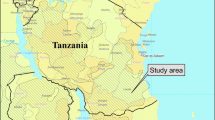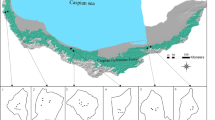Abstract
Grazing and fire are major factors influencing the savanna ecosystems of Southern Africa. In both grazing and conservation areas overgrazing is an important reason for degradation of vegetation and soil. Insufficient fire management can cause a change in the species composition and may influence the soil negatively. For adequate planning purposes the knowledge of available biomass is indispensable. High-resolution satellite systems can provide such knowledge on a large scale. Three study areas in Southern Africa contributed to a first survey. Gutu District is situated in Zimbabwe. In its Communal Lands a high population density leads to severe degradation of vegetation and soil. The South African test sites are located in Kruger National Park and Madikwe Game Reserve. Therefore a wide ecological range from highly degraded to slightly disturbed savanna ecosystems is included. Satellite images of both Landsat-5 (TM) and Landsat-7 (ETM+) were applied. After cross-calibration of the two different satellite systems, indices applied to radiance and reflectance showed significant correlations with ground truth data of grass and other foliage biomass. Including new data from Hluhluwe National Park (South Africa) into the regression models improved the results, indicating that a regional model for savanna ecosystems in Southern Africa could be found.
Similar content being viewed by others
References
Asrar G., Kanemasu E.T., Jackson R.D. and Pinter P.J., 1985: Estimation of Total Above-Ground Phytomass Production Using Remotely Sensed Data. Remote Sensing of Environment 17: 211–220.
Baas S., 1993: Weidepotential und Tragfähigkeit in Zentralsomalia. Abhandlungen-Anthropogeographie, Institut für Geographische Wissenschaften, Freie Universität Berlin, Band 51, Berlin.
Campbell B.M., Frost P. and Byron N., 1996: Miombo Woodlands and their Use: Overview and Key Issues. In: Campbell, B. (ed.), The Miombo in Transition: Woodlands and Welfare in Africa. Center for International Forestry Research (CIFOR), Bogor.
Chander G. and Markham B., 2003: Revised Landsat 5 TM Radiometric Calibration Procedures and Post-Calibration Dynamic Ranges. http://landsat7.usgs.gov/documents/L5TMCal2003.pdf, 23.7.2003.
Chenje M. and Johnson P. (eds), 1994: State of the Environment in Southern Africa. Southern African Research & Development Centre (SARDC), Harare.
Du Plessis W.P., 1997: Refinements to the Burning Strategy in the Etosha National Park. Koedoe 40(1): 63–76.
Dusek D.A., Jackson R.D. and Musick, J.T., 1985: Winter Wheat Vegetation Indices Calculated from Combinations of Seven Spectral Bands. Remote Sensing of Environment 18: 255–267.
Eckhardt H.C., van Wilgen B.W. and Biggs, H.C., 2000: Trends in Woody Vegetation Cover in the Kruger National Park, South Africa, between 1940 and 1998. African Journal of Ecology 38: 108–115.
Everitt J.H., Escobar D.E. and Richardson A.J., 1989: Estimating Grassland Phytomass Production with Near-Infrared and Mid-Infrared Spectral Variables. Remote Sensing of Environment 30: 257–261.
Franklin J. and Hiernaux P.H.Y., 1991: Estimation Foliage and Woody Biomass in Sahelian and Sudanian Woodland Using a Remote Sensing Model. International Journal of Remote Sensing 12/6: 1387–1404.
Franklin J. and Strahler A.H., 1988: Invertible Canopy Reflectance Modeling of Vegetation Structure in Semiarid Woodland. IEEE Transactions on Geoscience and Remote Sensing 26(6): 809–824.
Gardner B.R., Blad B.L., Thompson D.R. and Henderson K.E., 1985: Evaluation and Interpretation of Thematic Mapper Ratios in Equations for Estimating Corn Growth Parameters. Remote Sensing of Environment 18: 225–234.
Helldén U. and Olsson K., 1982: The Potential of Landsat MSS Data for Wood Resources Monitoring-A Study in Arid and Semi-arid Environment in Kordofan, The Sudan. - Lunds Universitets Naturgeografiska Institution Rapporter och Notiser 52, Lund.
Hildebrandt G. 1996: Fernerkundung und Luftbildmessung für Forstwirtschaft, Vegetationskartierung und Landschaftsökologie. Wichmann Verlag, Heidelberg.
Huang C., Wylie B., Yang L., Homer C., Zylstra G. 2002: Derivation of a Tasselled Cap Transformation based on Landsat 7 At-Satellite Reflectance. International Journal of Remote Sensing 23(8): 1741–1748.
Huntley B.J., 1982: Southern African Savannas. In: Huntley B.J. (ed.), Ecology of Tropical Savannas. Springer Verlag, Berlin, Heidelberg, New York.
Kraus, T. and Samimi, C., 2002: Biomass Estimation for Land Use Management and Fire Management using Landsat-TM and Landsat-ETM+. Erdkunde 56/2: 130–143.
Menz G., 1994: Biomasse und Satellitenfernerkundung: Zur Berechnung von Karten der oberirdischen Phytomasse von Kenya aus NOAA-NDVIDaten. Geomethodica 19: 149–188.
Moleele N., Ringrose, S., Arnberg W., Lunden B. and Vanderpost C., 2001: Assessment of Vegetation Indexes Useful for Browse (Forage) Prediction in Semi-arid Rangelands. International Journal of Remote Sensing 22(5): 741–756.
Mueller-Dombois D. and Ellenberg H., 1974: Aims and methods of Vegetation Ecology. John Wiley & Sons, New York, London, Sydney, Toronto.
Olsson K., 1984: Remote Sensing of Woody Vegetation-A Quantitative Approach in the Sudanese Drylands. Lunds Universitets Naturgeografiska Institution Rapporter och Notiser 57, Lund.
Peterson D.L. and Running S.W., 1989: Applications in Forest Science and Management. In: Asrar G. (ed.), Theory and Applications of Optical Remote Sensing. John Wiley & Sons, New York, Chichester, Brisbane, Toronto, Singapore.
Ringrose S., Vanderpost C. and Matheson, W., 1997: Use of Image Processing and GIS Techniques to Determine the Extent and Possible Causes of Land Management/Fenceline Induced Degradation Problems in the Okavango Area, Northern Botswana. International Journal of Remote Sensing 18(11): 2337–2364.
Rutherford M.C., 1982: Aboveground biomass categories of woody plants in a x Burkea africana-Ochna pulchra Savanna. Bothalia 14(1): 131–138.
Samimi C., 2000: Landnutzung und Umweltveränderung im Gutu Distrikt (Zimbabwe). In: Bähr J. and Jürgens U. (eds), Transformationsprozesse im Südlichen Afrika-Konsequenzen für Gesellschaft und Natur, pp 129–141, Kieler Geographische Schriften 104, Kiel.
Samimi C., 2003: Das Weidepotential im Gutu Distrikt-Möglichkeiten und Grenzen der Modellierung unter Verwendung von Landsat TM-5. Karlsruher Schriften zur Geographie und Geoökologie 19 Karlsruhe.
Shea R.W., Shea B.W., Kauffmann J.B., Ward D.E., Haskins C.I. and Scholes, M.C., 1996: Fuel Biomass and Combustion Factors Associated with Fires in Savanna Ecosystems of South Africa and Zambia. Journal of Geophysical Research 101(D19): 23551–23568.
Teillet P.M., Barker J.L., Markham B.L., Irish R.R., Fedosejevs G. and Storey J.C., 2001: Radiometric Cross-Calibration of the Landsat-7 ETM+ and Landsat-5 TM Sensors Based on Tandem Data Sets. Remote Sensing of Environment 78: 39–54.
Trollope W.S.W., Biggs H.C., Potgieter A.L.F. and Zambatis, N., 1996: A Structured versus a Laissez Faire Approach to Controlled Burning in the Kruger National Park in South Africa. Congress 31 of the Journal of the Grassland Society of Southern Africa. Nelspruit, South Africa.
Trollope W.S.W. and Potgieter; A.L.F., 1986: Estimating grass fuel loads with a disc pasture meter in the Kruger National Park. J. Grassl. Soc. Sth. Afr. 3(4): 148–152.
Tucker C.J., Vanpraet C.L., Boerwinkel E. and Gaston, A., 1983: Satellite Remote Sensing of Total Dry Matter Production in the Senegalese Sahel. Remote Sensing of Environment 13: 416–474.
Tucker C.J., Vanpret C.L., Sharman M.J. and Van Ittersum G., 1985: Satellite Remote Sensing of the Total Herbaceous Biomass Production in the Senegalese Sahel 1980-1984. Remote Sensing of Environment 17: 233–249.
Vincent V. and Thomas R.G., 1962: An Agricultural Survey of Southern Rhodesia: Part I, Agro-ecological Survey. Ministry of Agriculture, Salisbury (today Harare).
Wiegand C.S., Maas S.J., Aase J.K., Hatfield J.L., Pinter P.J., Jackson R.D., Kanemasu E.T. and Lapitan, R.L., 1992: Multisite Analyses of Spectral-Biophysical Data for Wheat. Remote Sensing of Environment 42: 1–21.
White F., 1983: The Vegetation of Africa. UNESCO, Paris.
Whitlow J.R. and Campbell, B.M., 1989: Factors Influencing Erosion in Zimbabwe: A Statistical Analysis. Journal of Environmental Management 29: 17–29.
Author information
Authors and Affiliations
Corresponding author
Rights and permissions
About this article
Cite this article
Samimi, C., Kraus, T. Biomass estimation using Landsat-TM and -ETM+. Towards a regional model for Southern Africa?. GeoJournal 59, 177–187 (2004). https://doi.org/10.1023/B:GEJO.0000026688.74589.58
Issue Date:
DOI: https://doi.org/10.1023/B:GEJO.0000026688.74589.58




